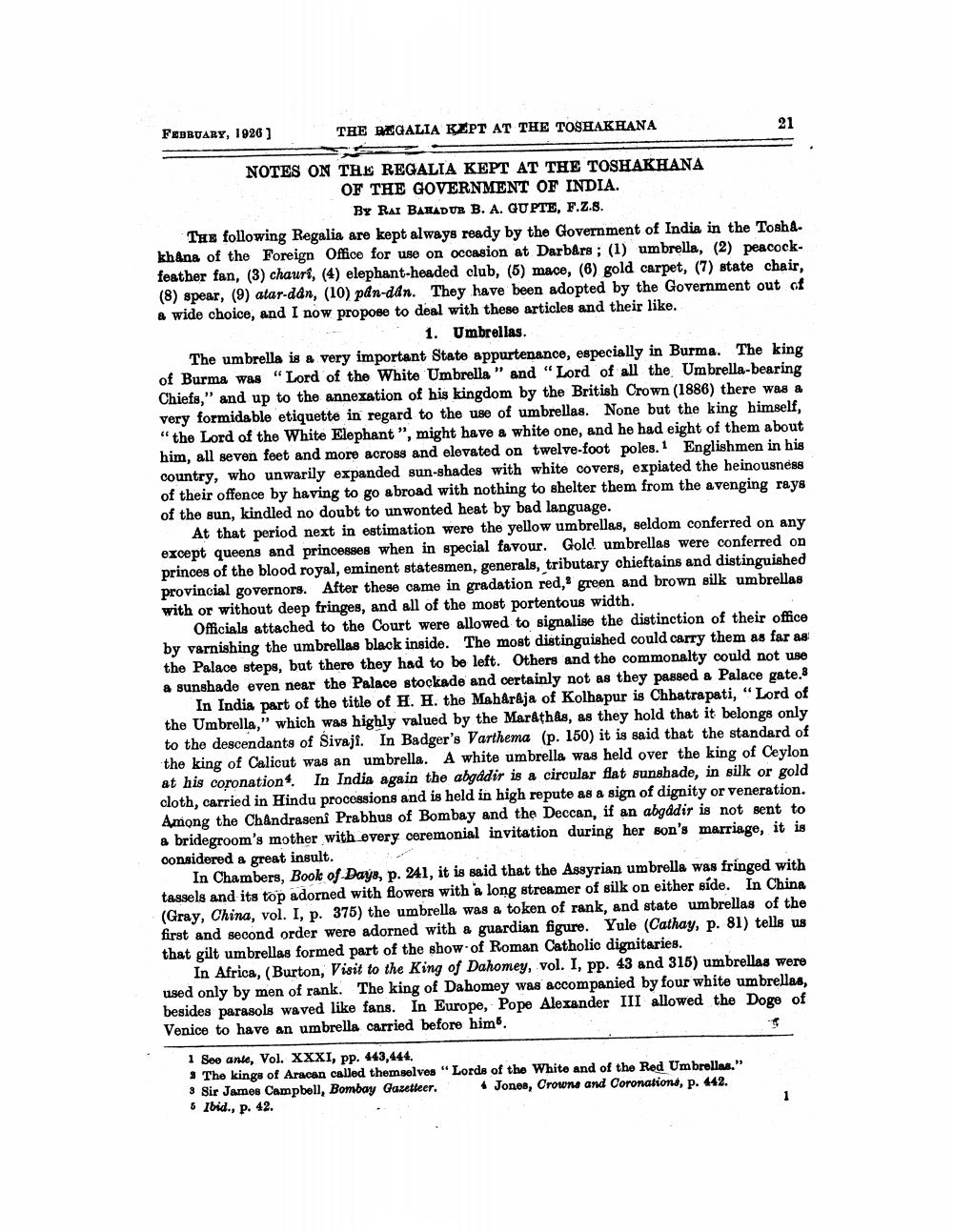________________
FEBRUARY, 1926 )
THE BEGALIA KEPT AT THE TOSHAKHANA
NOTES ON THE REGALIA KEPT AT THE TOSHAKHANA
OF THE GOVERNMENT OF INDIA.
By RAI BAHADUR B. A. GUPTE, F.Z.8. The following Regalia are kept always ready by the Government of India in the ToshdkhAns of the Foreign Office for use on occasion at Darbars; (1) umbrella, (2) peacockfeather fan, (3) chauri, (4) elephant-headed club, (5) mace, (6) gold carpet, (7) state chair, (8) spear, (9) atar-dan, (10) pan-dan. They have been adopted by the Government out of a wide choice, and I now propose to deal with these articles and their like.
1. Umbrellas. The umbrella is a very important State appurtenance, especially in Burma. The king of Burma was "Lord of the White Umbrella" and "Lord of all the Umbrella-bearing Chiefs," and up to the annexation of his kingdom by the British Crown (1886) there was a very formidable etiquette in regard to the use of umbrellas. None but the king himself, "the Lord of the White Elephant", might have a white one, and he had eight of them about him, all seven feet and more across and elevated on twelve-foot poles. 1 Englishmen in his country, who unwarily expanded sun-shades with white covers, expiated the heinousness of their offence by having to go abroad with nothing to shelter them from the avenging rays of the sun, kindled no doubt to unwonted heat by bad language.
At that period next in estimation were the yellow umbrellas, seldom conferred on any except queens and princesses when in special favour. Gold umbrellas were conferred on princes of the blood royal, eminent statesmen, generals, tributary chieftains and distinguished provincial governors. After these came in gradation red, green and brown silk umbrellas with or without deep fringes, and all of the most portentous width.
Officials attached to the Court were allowed to signalise the distinction of their office by Varnishing the umbrellas black inside. The most distinguished could carry them as far as the Palace steps, but there they had to be left. Others and the commonalty could not use a sunshade even near the Palace stockade and certainly not as they passed a Palace gate.
In India part of the title of H. H. the MaharAja of Kolhapur is Chhatrapati, "Lord of the Umbrella, which was highly valued by the MarathAs, as they hold that it belongs only to the descendants of Sivaji. In Badger's Varthema (p. 150) it is said that the standard of the king of Calicut was an umbrella. A white umbrella was held over the king of Ceylon at his coronation. In India again the abgadir is a circular flat sunshade, in silk or gold cloth, carried in Hindu processions and is held in high repute as a sign of dignity or veneration. Among the Chandraseni Prabhus of Bombay and the Deccan, if an abgddir is not sent to a bridegroom's mother with every ceremonial invitation during her son's marriage, it is considered a great insult.
In Chambers, Book of Days, p. 241, it is said that the Assyrian umbrella was fringed with tassels and its top adorned with flowers with a long streamer of silk on either side. In China (Gray, China, vol. I, p. 375) the umbrella was a token of rank, and state umbrellas of the first and second order were adorned with a guardian figure. Yule (Cathay, p. 81) tells us that gilt umbrellas formed part of the show of Roman Catholio dignitaries.
In Africa, (Burton, Visit to the King of Dahomey, vol. I, pp. 43 and 315) umbrellas were used only by men of rank. The king of Dahomey was accompanied by four white umbrellas, besides parasols waved like fans. In Europe, Pope Alexander III allowed the Doge of Venice to have an umbrella carried before him.
1 See ante, Vol. XXXI, pp. 443,444.
The kings of Aracan called themselves "Lords of the White and of the Red Umbrellas." 3 Sir James Campbell, Bombay Gazetteer. Jones, Crowns and Coronations, p. 442. 6 Ibid., p. 42.




